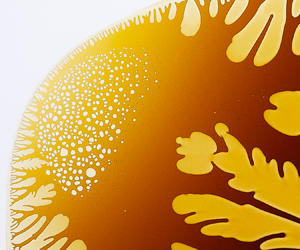Published online by Cambridge University Press: 26 August 2021

The behaviour of a viscous drop squeezed between two horizontal planes (a squeezed Hele-Shaw cell) is treated by both theory and experiment. When the squeezing force  $F$ is constant and surface tension is neglected, the theory predicts ultimate growth of the radius
$F$ is constant and surface tension is neglected, the theory predicts ultimate growth of the radius  $a\sim t^{1/8}$ with time
$a\sim t^{1/8}$ with time  $t$. This theory is first reviewed and found to be in excellent agreement with experiment. Surface tension at the drop boundary reduces the interior pressure, and this effect is included in the analysis, although it is negligibly small in the squeezing experiments. An initially elliptic drop tends to become circular as
$t$. This theory is first reviewed and found to be in excellent agreement with experiment. Surface tension at the drop boundary reduces the interior pressure, and this effect is included in the analysis, although it is negligibly small in the squeezing experiments. An initially elliptic drop tends to become circular as  $t$ increases. More generally, the circular evolution is found to be stable under small perturbations. If, on the other hand, the force is reversed (
$t$ increases. More generally, the circular evolution is found to be stable under small perturbations. If, on the other hand, the force is reversed ( $F<0$), so that the plates are drawn apart (the ‘contraction’, or ‘lifting plate’, problem), the boundary of the drop is subject to a fingering instability on a scale determined by surface tension. The effect of a trapped air bubble at the centre of the drop is then considered. The annular evolution of the drop under constant squeezing is still found to follow a ‘one-eighth’ power law, but this is unstable, the instability originating at the boundary of the air bubble, i.e. the inner boundary of the annulus. The air bubble is realised experimentally in two ways: first by simply starting with the drop in the form of an annulus, as nearly circular as possible; and second by forcing four initially separate drops to expand and merge, a process that involves the resolution of ‘contact singularities’ by surface tension. If the plates are drawn apart, the evolution is still subject to the fingering instability driven from the outer boundary of the annulus. This instability is realised experimentally by levering the plates apart at one corner: fingering develops at the outer boundary and spreads rapidly to the interior as the levering is slowly increased. At a later stage, before ultimate rupture of the film and complete separation of the plates, fingering spreads also from the boundary of any interior trapped air bubble, and small cavitation bubbles appear in the very low-pressure region, far from the point of leverage. This exotic behaviour is discussed in the light of the foregoing theoretical analysis.
$F<0$), so that the plates are drawn apart (the ‘contraction’, or ‘lifting plate’, problem), the boundary of the drop is subject to a fingering instability on a scale determined by surface tension. The effect of a trapped air bubble at the centre of the drop is then considered. The annular evolution of the drop under constant squeezing is still found to follow a ‘one-eighth’ power law, but this is unstable, the instability originating at the boundary of the air bubble, i.e. the inner boundary of the annulus. The air bubble is realised experimentally in two ways: first by simply starting with the drop in the form of an annulus, as nearly circular as possible; and second by forcing four initially separate drops to expand and merge, a process that involves the resolution of ‘contact singularities’ by surface tension. If the plates are drawn apart, the evolution is still subject to the fingering instability driven from the outer boundary of the annulus. This instability is realised experimentally by levering the plates apart at one corner: fingering develops at the outer boundary and spreads rapidly to the interior as the levering is slowly increased. At a later stage, before ultimate rupture of the film and complete separation of the plates, fingering spreads also from the boundary of any interior trapped air bubble, and small cavitation bubbles appear in the very low-pressure region, far from the point of leverage. This exotic behaviour is discussed in the light of the foregoing theoretical analysis.
This movie was created in three stages, using the same camera for each stage: initial stage 1 is a video of duration 174s; squeezing stage 2 is a succession of stills at 10s intervals, lasting for 7m 50s; levering (fingering) stage 3 is a video of duration 77s; the whole is compressed for aesthetic reasons.This movie was created in three stages, using the same camera for each stage: initial stage 1 is a video of duration 174s; squeezing stage 2 is a succession of stills at 10s intervals, lasting for 7m 50s; levering (fingering) stage 3 is a video of duration 77s; the whole is compressed for aesthetic reasons.
This movie was created in three stages, using the same camera for each stage: initial stage 1 is a video of duration 215s; squeezing stage 2 is a succession of stills at 10s intervals, lasting for 7h 42m 24s; levering (fingering) stage 3 is a video of duration 109s; the whole is compressed for aesthetic reasons.
This movie was created in three stages, using the same camera for each stage: initial stage 1 is a video of duration 179s; squeezing stage 2 is a succession of stills at 10s intervals, lasting for 7m 58s; levering (fingering) stage 3 is a video of duration 76s; the whole is compressed for aesthetic reasons.